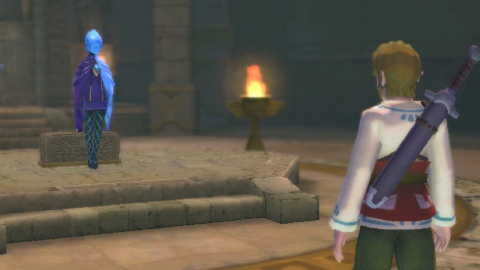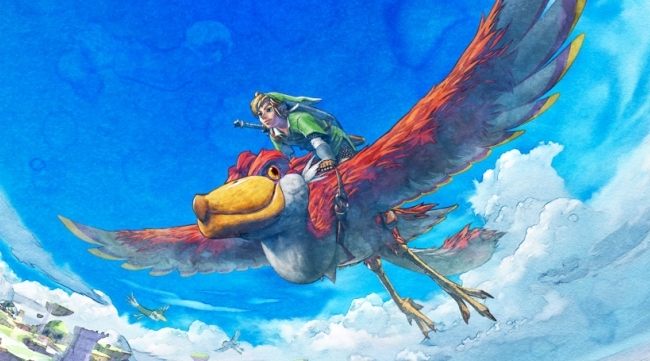The Legend of Zelda: Skyward Sword
| The Legend of Zelda: Skyward Sword | |
|---|---|
 |
|
| Platforms | Wii |
| Genre | I just flew in from Hyrule, and boy are my arms tired! |
| Score | 9  |
| Buy from Amazon | |
The lasting impression from my recent introduction to the original Legend of Zelda was its unstructured progression. With only a ghost of a narrative driving the action and few barriers to limit wanderlust, the course of my trip through Hyrule was almost entirely up to me. Having played Ocarina of Time before any other Zelda game, I was surprised to see just how hands-off the original was.
In contrast, last month's Skyward Sword may be the most linear Zelda experience yet. The newest quest sees Link flying from one compact landmass to the next with hardly any room for side trips. The vast sky of islands is sparser than Wind Waker's nearly endless ocean, and even the surface world below is but three masses of land separated by impenetrable mountain ranges and deserts and forests. This is a Zelda where the path to the next waypoint is often the only path.
Every game in the series since the eighties original has trended towards structure and direction as story progression and ability acquisition gained a greater share of the Zelda spirit. Aesthetic similarities and recurring tropes aside, The Legend of Zelda and Skyward Sword could be mistaken for two wholly separate franchises. For better or worse, Skyward Sword feels like the end state of a slow evolution that Nintendo has been cooking for twenty-five years.
Much of Skyward Sword's linear structuring can be attributed to its procedural narrative. The newest adventure's gradual plot developments necessitate a more guided experience than the NES classic, in which story sequences only bookended the adventure. Skyward Sword isn't alone in this, as games from 1991's A Link to the Past onward used physical barriers in the game world to funnel the player towards the next key objective. It is, however, the most draconian in its restrictions: where Zelda game worlds are usually made up of one vast overworld with key areas and side distractions equally scattered about, Skyward Sword drops Link (literally) into each new surface region with one route to the next goal and nary a hidden nook or cranny out of immediate sight.
The trade isn't necessarily one-sided: Skyward Sword exchanges the pre-dungeon free-range horseback wandering of Twilight Princess for obstacle courses dense with combat and puzzles. You'll also spend plenty of time retreading familiar ground to take on new challenges (thankfully, your first trip through each area unlocks a network of shortcuts to expedite subsequent trips). How you feel about this shift will hinge on whether you prefer finding an unexplored cave a mile east of your destination or outsmarting pesky fire-breathers that live in a bomb-sized tunnel.
It certainly helps that the brain teasing in Skyward Sword is the best of Zelda's lifetime. The newest adventure presents some of the most creative and rewarding puzzles in the series, somehow squeezing an impressive amount of unique challenges out of a relatively small number of tools. Better yet, the game breaks a number of bad habits picked up through the years. Many tedious and well-worn mental exercises are thankfully absent: no more pushing stone cubes across the temple floor, reflecting light paths via rotating mirrors, or shuffling between water levels and iron boots. And for a refreshing change, each item in Link's inventory is actually useful outside of the area where it's found. While the remote controlled Beetle might be the star of its own dungeon, it doesn't hog the spotlight for too long (a problem in Twilight Princess' bloated temples) and is regularly revisited throughout the rest of the adventure. That goes for the other seven versatile tools as well.
Combat, too, is better than ever, thanks to the integration of Wii MotionPlus' gyroscopic measurements. Using the peripheral controller add-on, the game can accurately track the tilt and angle of the controller in your hand, translating to an impressive on-screen replication. Nearly every enemy in the game can only be dispatched with some deliberate swordplay, whether it's baiting a goblin's guard to one side and striking from the other or flipping an armored spider onto its back with an upward lunge. Self defense finally requires some higher functioning as well, thanks to varying shield durability and weaknesses (wood shield can be set afire, iron shield is a lightning rod) and a timing-based parry that opens up enemies for counter attacks. Bosses, heretofore the "final exam" for the key tool that you acquire in its abode, are now skewed heavily towards swordplay. Half of the boss encounters actually require no equipment but the blade alone, yet they feel no less cerebral than the standard search for the right tool to expose glowing weak spots. For the first time, Zelda combat is enjoyable action rather than forgettable obligation.
However, Nintendo seems a bit too pleased with their motion control successes, as waggle gets shoehorned into every aspect of the game with minimal regard for convenience or actual value. For every little success, like rolling bombs Wii Bowling-style or the bug net that follows your motions exactly, there is a an instance where the arm-swinging effort just detracts from the experience. It gets no worse than soaring above the clouds on your Loftwing: piloting your giant red bird is akin to twisting a doorknob and cracking a whip at the same time. The smart gestures outweigh the waggle, but they don't excuse it.
Motion controls and linearization change up the formula more than most Zelda iterations, but the narrative context sticks stubbornly close to tradition. Skyward Sword is a standard hero's journey, conquering the dangers of mysterious foreign lands before confronting the ultimate evil. Link (or whatever snarky name you give the hero) is a knight in training who happens to be the goddess' chosen champion. He must descend from Skyloft, his hometown floating in the sky, to the mysterious surface world beneath the clouds in order to rescue his childhood friend Zelda and seal away an ancient evil by collecting enchanted artifacts. Heroes and villains alike are often entertaining (if also easily forgotten), the sights and sounds of the journey bring the magic, and those interested in the vaguely connected Zelda lore might enjoy the origin tales of the Master Sword and a certain recurring villain, but the story may be the most predictable since Ocarina of Time paved the way for epic action-adventure stories nearly fifteen years ago. Skyward Sword desperately needs an character or conflict to convey personal growth or drama but has nothing of the sort to hook onto.
In fact, the two characters that share the overwhelming majority of screen time are barely characters at all. Where the supporting cast has at least learned to speak in a subtitled gibberish in the past quarter-century, the leading man's expressive ability remains stunted at the level of a toddler that can only smile in delight or wail in pain. His omnipresent counterpart, a spirit called Fi, is the more disappointing of the duo. She explains the importance of each step in the adventure and spews copious tutorial information (often pointing out the obvious) with a dull robotic probability shtick that ages faster than a Portal meme. The one moment near the end of the game where Link and Fi actually have a meaningful interaction feels forced and phony; it's even outdone by a parallel sequence between two other characters with about fifteen minutes of combined screen time. Plenty of supporting characters enter and exit the stage in a single scene with style bursting from their animations and lively dialog (the bazaar in Skyloft is brimming with delightful folk), so it's a shame that the one with the most to say isn't worth listening to. Frankly, the game would be better off without Fi, all else unchanged, if only to curtail the nagging tutorials.
Nintendo may not have cut Fi, but Skyward Sword as a whole shows that addition by subtraction is not a foreign concept to the creative team. By paring down the overworld real estate and dungeon depths, the developers have crafted the leanest Zelda yet without sacrificing lasting value. The first conquest lasts about forty hours, with another ten to spend playing minigames and running errands around Skyloft. A second quest with tougher enemies awaits after completion as well, and I'm surprised to find that I could happily start it right now when I usually dread replaying a Zelda game. Come to think of it, I've been meaning to get started on the original Legend of Zelda's remixed second quest as well. Perhaps the two titles are more alike than I thought.
In my mind, the journey from one end of the Zelda spectrum to the other is complete. The wide open Legend of Zelda has begotten a dozen successors, each drifting away from those roots towards the heavily-scripted Skyward Sword. And yet the series has never so much as dipped in quality in all that time, rolling with the iterative changes and perennially delighting fans. I wouldn't mind more of the same, but the franchise's handlers recently expressed interest in re-thinking Zelda's direction. Having now experienced the enduring merit of both alpha and omega, I have faith that any paradigm shift would live up to the Legend.





